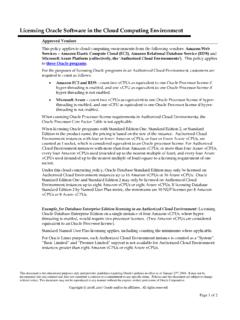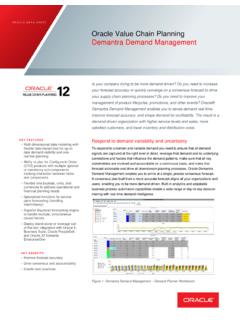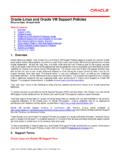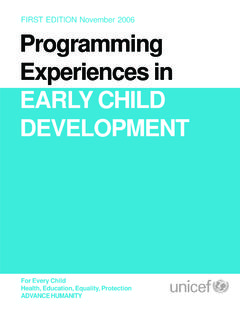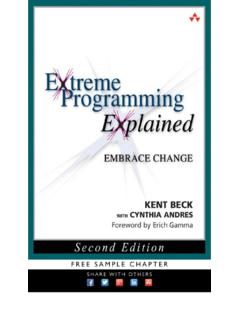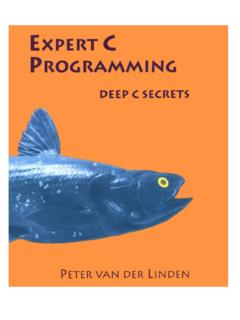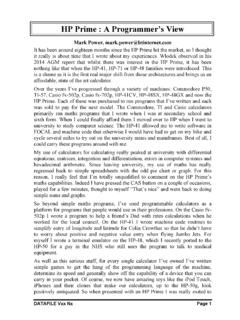Transcription of Chapter 1
1 BeginNew-Tight / java : a beginner s guide , Fifth Edition / Herb Schildt / 632-7 / Chapter 11 Chapter 1 java 17/20/11 3:04:32 PMBeginNew-Tight / java : a beginner s guide , Fifth Edition / Herb Schildt / 632-7 / Chapter 1 2 java : A beginner s GuideKey Skills & Concepts Know the history and philosophy of java Understand java s contribution to the Internet Understand the importance of bytecode Know the java buzzwords Understand the foundational principles of object-oriented programming Create, compile, and run a simple java program Use variables Use the if and for control statements Create blocks of code Understand how statements are positioned, indented, and terminated Know the java keywords Understand the rules for java identifiersThe rise of the Internet and the World Wide Web fundamentally reshaped computing. Prior to the Web, the cyber landscape was dominated by stand-alone PCs.
2 Today, nearly all PCs are connected to the Internet. The Internet, itself, was transformed originally offering a convenient way to share files and information. Today it is a vast, distributed computing universe. With these changes came a new way to program: is the preeminent language of the Internet, but it is more than that. java revolutionized programming , changing the way that we think about both the form and the function of a program. To be a professional programmer today implies the ability to program in java it is that important. In the course of this book, you will learn the skills needed to master purpose of this Chapter is to introduce you to java , including its history, its design philosophy, and several of its most important features. By far, the hardest thing about learning a programming language is the fact that no element exists in isolation. Instead, the components of the language work in conjunction with each other.
3 This interrelatedness is especially pronounced in java . In fact, it is difficult to discuss one aspect of java without involving others. To help overcome this problem, this Chapter provides a brief overview of several java features, including the general form of a java program, some basic control structures, and operators. It does not go into too many details but, rather, concentrates on the general concepts common to any java 27/20/11 3:04:32 PMBeginNew-Tight / java : a beginner s guide , Fifth Edition / Herb Schildt / 632-7 / Chapter 1 BeginNew-Tight / java : a beginner s guide , Fifth Edition / Herb Schildt / 632-7 / Chapter 1 Chapter 1: java Fundamentals 3 The Origins of JavaComputer language innovation is driven forward by two factors: improvements in the art of programming and changes in the computing environment. java is no exception. Building upon the rich legacy inherited from C and C++, java adds refinements and features that reflect the current state of the art in programming .
4 Responding to the rise of the online environment, java offers features that streamline programming for a highly distributed was conceived by James Gosling, Patrick Naughton, Chris Warth, Ed Frank, and Mike Sheridan at Sun Microsystems in 1991. This language was initially called Oak but was renamed java in 1995. Somewhat surprisingly, the original impetus for java was not the Internet! Instead, the primary motivation was the need for a platform-independent language that could be used to create software to be embedded in various consumer electronic devices, such as toasters, microwave ovens, and remote controls. As you can probably guess, many different types of CPUs are used as controllers. The trouble was that (at that time) most computer languages were designed to be compiled for a specific target. For example, consider C++.Although it was possible to compile a C++ program for just about any type of CPU, to do so required a full C++ compiler targeted for that CPU.
5 The problem, however, is that compilers are expensive and time-consuming to create. In an attempt to find a better solution, Gosling and others worked on a portable, cross-platform language that could produce code that would run on a variety of CPUs under differing environments. This effort ultimately led to the creation of the time that the details of java were being worked out, a second, and ultimately more important, factor emerged that would play a crucial role in the future of java . This second force was, of course, the World Wide Web. Had the Web not taken shape at about the same time that java was being implemented, java might have remained a useful but obscure language for programming consumer electronics. However, with the emergence of the Web, java was propelled to the forefront of computer language design, because the Web, too, demanded portable programmers learn early in their careers that portable programs are as elusive as they are desirable.
6 While the quest for a way to create efficient, portable (platform-independent) programs is nearly as old as the discipline of programming itself, it had taken a back seat to other, more pressing problems. However, with the advent of the Internet and the Web, the old problem of portability returned with a vengeance. After all, the Internet consists of a diverse, distributed universe populated with many types of computers, operating systems, and was once an irritating but a low-priority problem had become a high-profile necessity. By 1993 it became obvious to members of the java design team that the problems of portability frequently encountered when creating code for embedded controllers are also found when attempting to create code for the Internet. This realization caused the focus of java to switch from consumer electronics to Internet programming . So, while it was the desire for an architecture-neutral programming language that provided the initial spark, it was the Internet that ultimately led to java s large-scale 37/20/11 3:04:32 PMBeginNew-Tight / java : a beginner s guide , Fifth Edition / Herb Schildt / 632-7 / Chapter 1 4 java : A beginner s GuideHow java Relates to C and C++ java is directly related to both C and C++.
7 java inherits its syntax from C. Its object model is adapted from C++. java s relationship with C and C++ is important for several reasons. First, many programmers are familiar with the C/C++ syntax. This makes it easy for a C/C++ programmer to learn java and, conversely, for a java programmer to learn C/C++.Second, java s designers did not reinvent the wheel. Instead, they further refined an already highly successful programming paradigm. The modern age of programming began with C. It moved to C++, and now to java . By inheriting and building upon that rich heritage, java provides a powerful, logically consistent programming environment that takes the best of the past and adds new features required by the online environment. Perhaps most important, because of their similarities, C, C++, and java define a common, conceptual framework for the professional programmer. Programmers do not face major rifts when switching from one language to of the central design philosophies of both C and C++ is that the programmer is in charge!
8 java also inherits this philosophy. Except for those constraints imposed by the Internet environment, java gives you, the programmer, full control. If you program well, your programs reflect it. If you program poorly, your programs reflect that, too. Put differently, java is not a language with training wheels. It is a language for professional programmers. java has one other attribute in common with C and C++: it was designed, tested, and refined by real, working programmers. It is a language grounded in the needs and experiences of the people who devised it. There is no better way to produce a top-flight professional programming of the similarities between java and C++, especially their support for object-oriented programming , it is tempting to think of java as simply the Internet version of C++. However, to do so would be a mistake. java has significant practical and philosophical differences.
9 Although java was influenced by C++, it is not an enhanced version of C++. For example, it is neither upwardly nor downwardly compatible with C++. Of course, the similarities with C++ are significant, and if you are a C++ programmer, you will feel right at home with java . Another point: java was not designed to replace C++. java was designed to solve a certain set of problems. C++ was designed to solve a different set of problems. They will coexist for many years to java Relates to C#A few years after the creation of java , Microsoft developed the C# language. This is important because C# is closely related to java . In fact, many of C# s features directly parallel java . Both java and C# share the same general C++-style syntax, support distributed programming , and utilize the same object model. There are, of course, differences between java and C#, but the overall look and feel of these languages is very similar.
10 This means that if you already know C#, then learning java will be especially easy. Conversely, if C# is in your future, then your knowledge of java will come in the similarity between java and C#, one might naturally ask, Will C# replace java ? The answer is No. java and C# are optimized for two different types of computing environments. Just as C++ and java will coexist for a long time to come, so will C# and 47/20/11 3:04:32 PMBeginNew-Tight / java : a beginner s guide , Fifth Edition / Herb Schildt / 632-7 / Chapter 1 BeginNew-Tight / java : a beginner s guide , Fifth Edition / Herb Schildt / 632-7 / Chapter 1 Chapter 1: java Fundamentals 5 java s Contribution to the InternetThe Internet helped catapult java to the forefront of programming , and java , in turn, had a profound effect on the Internet. In addition to simplifying web programming in general, java innovated a new type of networked program called the applet that changed the way the online world thought about content.
